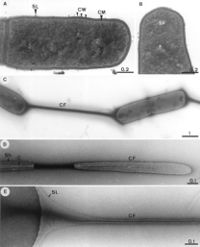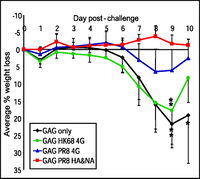Clostridium glycolicum
Overview
Clostridium glycolicum is a gram-positive, central to subterminal spore-forming rod with flagella uniformly distributed around the body. When grown on anaerobic agar, colonies were white and grey in color, 1-3 mm, and transparent. First isolated from mud in 1963. Found in other soils, sea grass roots, olive mill wastewater, snake venom, bovine and human feces. It has been shown that it is endemic, and a natural part of the gut microbiome of animals and humans. Has also been found in wounds of animals and humans, as well as abscesses and peritoneal fluid-fluid in the abdomen. (1,2,3,4,5)
Taxonomy
Clostridium: From the Greek word kloster or spindle. Individual cells are rod-shaped.
Glycolicum: Glyco-from the Greek word glykýs or sweet, relating to sugar. Involved in sugar fermentation.(6)
Phylum: Firmicutes
Class: Clostridia
Order: Clostridiales
Family: Peptostreptococcaceae
unclassified Peptostreptococcaceae
Genus: Clostridium
Species:glycolicum

Metabolism
C. Glycolicum utilizes ethylene glycol as carbon and energy source. Also shown to ferment glucose, fructose, sorbitol, dulcitol and cellulose. Reduces CO2, using hydrogen as an electron source, and produces acetate. (1)
2 CO2 + 4 H2 CH3COOH + 2 H2O

Metabolism and Strain Variance
While C. Glycolicum usually performs metabolic activity under anoxic conditions, certain strains such as RD-1 are aerotolerant. Oxic conditions lead to the oxidation of glucose whereas anoxic conditions lead to the reduction CO2 via the acetyl-CoA pathway. (4)
Strain RD-1: H2-C02 utilization on formate, lactate, or pyruvate. Aerotolerance and utilization of oxygen. Growth on sugars and ethylene glycol yields acetate and ethanol. Tolerates limited amounts of oxygen. Isolated from sea grass roots.(4)
Strain DSM 1288: Negligible H2 utilization as well as limited ability to use formate. Characterized as a fermentative anaerobe.(4)
Strain Kha: Acetate is sole product under anoxic conditions. (2)
Symbiosis
Two functionally linked bacteria, KHa (acetogenic strain of Clostridium glycolicum) and KHb (Bacteroides xylanolyticus) found co-habiting Hawaiian forest soil. KHb ferments xylan and other saccharides that KHa cannot utilize. KHb also utilizes large amounts of oxygen and forms products such as ethanol and H2 that supports the acetogenic growth of KHa.(2)
References
(1) Gaston, Lamont W., and E.R. Stadtman. "FERMENTATION OF ETHYLENE GLYCOL BY CLOSTRIDIUM GLYCOLICUM, SP. N1." Journal of Bacteriology 85.2 (1963): 356-62. Web. 21 Apr. 2014. <http://www.ncbi.nlm.nih.gov/pmc/articles/PMC278141/>.
(2) Hunger, Sindy, et al. "Trophic Links between the Acetogen Clostridium glycolicum KHa and the Fermentative Anaerobe Bacteroides xylanolyticus KHb, Isolated from Hawaiian Forest Soil." Applied and Environmental Biology 77.17 (2011): 6281-85. Web. 21 Apr. 2014. <http://www.ncbi.nlm.nih.gov/pmc/articles/PMC3165425/>.
(3) Jiang, Wei, et al. "Clostridium glycolicum Wound Infections: Case Reports and Review of the Literature▿." Journal of Clinical Microbiology 47.5 (2009): 1599-601. Web. 21 Apr. 2014. <http://jcm.asm.org/content/47/5/1599.full>.
(4) Kusel, Kirsten, et al. "Physiological Ecology of Clostridium glycolicum RD-1, an Aerotolerant Acetogen Isolated from Sea Grass Roots." Applied and Environmental Biology 67.10 (2001). Web. 21 Apr. 2014. <http://aem.asm.org/content/67/10/4734.full>.
(5) Van Leer, C. "Clostridium glycolicum Isolated from a Patient with Otogenic Brain Abscesses." Journal of Clinical Microbiology 47.2: 511-13. Web. 21 Apr. 2014. <http://www.ncbi.nlm.nih.gov/pmc/articles/PMC2643689/>.
